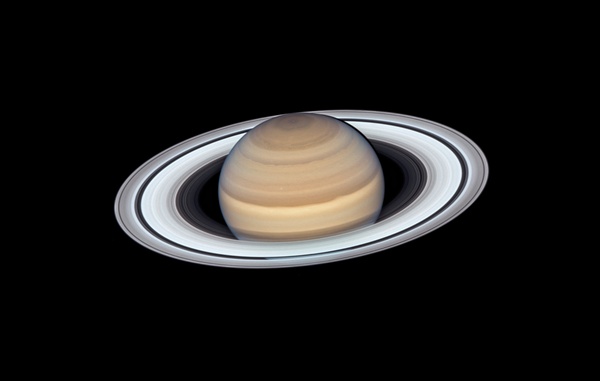The Sky This Week from September 20 to 29 – Astronomy Magazine
The ringed planet shines brightly
The Hubble Space Telescope captured this view of Saturn when it was close to Earth this past summer. Observers can still get marvelous views of the ringed world through backyard scopes.
NASA/ESA/A. Simon (GSFC)/M.H. Wong (UC, Berkeley)
Although magnificent Saturn reached its peak more than two months ago, our view of the ringed planet remains spectacular. It resides among the background stars of Sagittarius the Archer, a region that appears highest in the south during the latter stages of twilight and doesn’t set until after midnight local daylight time. Saturn continues to shine brightly, too, at magnitude 0.5. When viewed through a telescope, the planet’s disk measures 17″ across while the dramatic ring system spans 38″ and tilts 25° to our line of sight.
Friday, September 27
Neptune appeared at its best at opposition earlier this month, but its visibility hardly suffers this week. The outermost major planet lies in the southeastern sky once darkness falls and climbs highest in the south around midnight local daylight time. Neptune glows at magnitude 7.8, which is bright enough to spot through binoculars if you know where to look. The trick is to find the 4th-magnitude star Phi (φ) Aquarii, which lies about 15° (two binocular fields) east-southeast of Aquarius’ distinctive Water Jar asterism. Tonight, Neptune appears just 0.6° west-southwest of Phi. When viewed through a telescope, the ice giant planet shows a blue-gray disk measuring 2.4″ across.
The Moon reaches perigee, the closest point in its orbit around Earth, at 10:24 p.m. EDT. It then lies 222,328 miles (357,802 kilometers) away from us.
Saturday, September 28
New Moon occurs at 2:26 p.m. EDT. At its New phase, the Moon crosses the sky with the Sun and so remains hidden by our star. Because the Moon reached its closest point to Earth yesterday evening, residents in coastal areas can expect higher than normal tides for the next few days.
The Moon’s absence from the morning sky these next two weeks provides observers with an excellent opportunity to view the zodiacal light. From the Northern Hemisphere, the time around the autumnal equinox is the best for viewing the elusive glow before sunrise. It appears slightly fainter than the Milky Way, so you’ll need a clear moonless sky and an observing site located far from the city. Look for a cone-shaped glow that points nearly straight up from the eastern horizon shortly before morning twilight begins (around 5:30 a.m. local daylight time at mid-northern latitudes). The Moon remains out of the morning sky until October 12, when the waxing gibbous returns and overwhelms the much fainter zodiacal light.
Sunday, September 29
The variable star Algol in Perseus reaches minimum brightness at 12:34 a.m. EDT tomorrow morning. Observers on the East Coast who start watching around midevening can see the star’s brightness diminish by 70 percent over the course of about five hours. Those in western North America will see Algol brighten noticeably from late evening until dawn starts to paint the sky, when the star stands high in the west. This eclipsing binary system runs through a cycle from minimum (magnitude 3.4) to maximum (magnitude 2.1) and back every 2.87 days.







